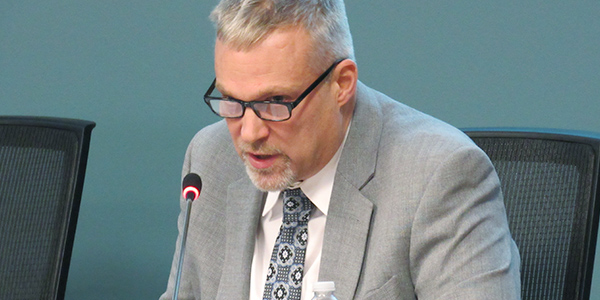By Amanda Durish Cook
CARMEL, Ind. — While MISO expects to have ample resources on hand to manage what should be a warmer-than-normal winter, it is still preparing for the possibility of entering emergency procedures.
The RTO is forecasting a 103-GW peak this winter, 6 GW short of the all-time winter record of 109 GW, set Jan. 6, 2014, during the polar vortex. With 140 GW in total available capacity to meet demand, the RTO foresees having a 36% systemwide reserve margin this winter, more than double the current annual level.
But Executive Director of Energy Rob Benbow told an Oct. 29 winter readiness workshop that MISO is preparing for the possibility of extreme winter conditions and estimates a 40% probability of having to call on load-modifying resources (LMRs) at least one time during the season.
“While we project ample resources under normal operating conditions, MISO is also prepared to proactively manage potential challenges created by periods of extreme weather, generation and transmission outages and other developments,” Benbow said.
MISO’s most probable operating scenario shows about 25.1 GW of outages with 18.8 GW in reserves. But in a high load and extreme outage scenario, outages could reach 38.6 GW, resulting in an almost 2-GW shortfall in reserves.
Resource Adequacy Coordination Engineer Eric Rodriguez said it’s “critical” that LMR owners update their wintertime availability in MISO’s nonpublic communication system to ensure readiness in the face of above-normal load or outages.
“We’re showing a challenging winter if a high-load, high-outage scenario is realized,” Rodriguez said.
MISO’s biannual coordinated seasonal assessment, which simulates stressors on the transmission system, showed no unanticipated thermal, voltage or phase angle issues this winter.
“Our transmission system also looks like it’s in good shape for this winter,” Benbow said.
However, MISO said it could experience delayed injections in the natural gas pipeline system and the region is experiencing the lowest gas storage levels in a decade due to a long cold snap in spring and high summertime demand.
But the RTO also predicts current high gas production will offset the low storage levels this winter, likely keeping prices flat. It also noted two new large pipelines from the Marcellus and Utica basins were placed into service last month and are increasing takeaway capacity.
“We have two new pipelines to offset the storage and we’re looking pretty good heading into winter,” said Trevor Hines, MISO operations communications lead.
More Precautions
This marks the first winter MISO will use its new capacity advisory notification, an intermediary step before declaring a maximum generation alert and used only when all-in capacity is forecast to be less than 5% above operating needs. (See MISO: Sept. Emergency Response Improved by Jan. Event.)
Benbow said MISO has been working through drills and training on emergency purchases with suppliers outside the footprint. MISO has also clarified its emergency operating procedures to ensure public appeals for energy conservation occur before MISO makes emergency energy purchases from external suppliers, a revision some members had advocated.
In response to the Jan. 17 MISO South emergency, MISO and SPP have been collaborating on both emergency protocols and the use of SPP’s contract path linking MISO’s Midwest and South regions, “making sure we understand when they’re having challenging times … and also making sure they understand our [emergency] process,” Benbow said.
“Ever since we’ve got out of the Jan. 17 event, we’ve met with the joint parties and our neighboring reliability coordinators to the South … to work on the management of the regional dispatch transfer,” he said.
5th Waiver
For the fifth straight winter, MISO is seeking a Tariff waiver to allow resources to recover energy costs in excess of the current $1,000/MWh offer cap.
In early October, FERC granted MISO an October 2020 deadline to implement a new $2,000/MWh hard cap for verified cost-based incremental energy offers. MISO said it needed the extra time to work the new offer caps into its fast-start pricing and extended locational marginal price. (See MISO Granted Longer Deadline for Offer Caps.)
MISO market adviser Chuck Hansen said if FERC approves the waiver, generator offers greater than $1,000/MWh will again be subject to the RTO’s verification process.
“They won’t be able to directly submit those offers, but they will be able to recover those costs after the fact through uplift costs,” Hansen said.





